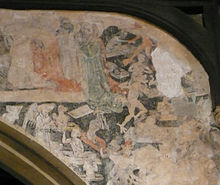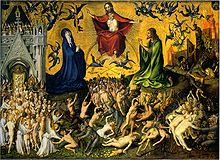- Doom paintings
-
 Last Judgement by Fra Angelico, panel painting, 1387 or 1395
Last Judgement by Fra Angelico, panel painting, 1387 or 1395
A Doom is a traditional English term for a painting or other image of the Last Judgment, an event in Christian eschatology. Christ judges souls, and then sends them to either Heaven or Hell. The subject was very commonly painted on a large scale on the western wall of churches, so it was viewed as people left the church, and the term is typically used of these, rather than depictions of the Last Judgement in other locations or media. Many examples survive as wall-paintings in medieval churches, most dating from around the 12th to 13th centuries, although the subject was common from the 1st millenium until (in countries remaining Catholic) the Counter-Reformation. The most famous of all doom paintings, The Last Judgment by Michelangelo in the Sistine Chapel, painted in 1537 to 1541, comes at the end of the tradition, and is unusually sited on the east wall behind the altar.
Doom or "the Doom" was a specific term for the Last Judgement, first cited to c. 1200 by the OED ("Doom", 6), a sense surviving in this artistic meaning and in phrases such as the "crack of doom" and the word "doomsday", the latter going back to Old English. The original OED in the late 19th century already described this sense of "doom" as "archaic", but it remains in use in descriptions of (mostly) British medieval churches.[1]
Dooms were encouraged by the early medieval Church as an instrument to highlight the contrasts between the reward of Heaven and the agony of Hell so as to guide Christians away from misbehaviour and sin. A Doom was usually positioned either on the rear (liturgical Western) wall, if that space was available, or at the front (Chancel end) of a church, often on the Chancel arch itself so that it would be constantly visible to worshipers as they faced the altar during services.
Although there are many different versions, the theme's format stays broadly the same. On the left side of a Doom painting (that is, on Christ's right hand) is Heaven, whilst on the right (Christ's left) is Hell. At the top of the image Jesus Christ sits in glory with his (proper - ie on the left to the viewer) right hand encouraging the saved up and his left hand pointing down to Hell for the damned. Typically flanking him is the Virgin Mary on his right and John the Apostle on his left, sometimes with the twenty-four elders mentioned in the Book of Revelation encircling the three of them. The angels blow trumpets to raise the dead for judgment. Commonly the Archangel Michael is in the centre, with the scales he will use to weigh the souls of humanity to see if individually they are fit for Heaven: one person is on one side of the scale while demonic creatures that represent the sins committed by the person are on the other side of the scale. The creatures try to tip the scales in their favour while, in some versions of the painting, The Virgin Mary places a rosary next to the person she wishes to protect, or puts her hand on the scale to counterbalance the demons. In some other versions, while one of the saved enters Heaven, a demon tries to pull them in with the damned, while an angel fights the demon for the soul.
Those who are worthy are brought to the gates of Heaven, frequently represented by a castle with large walls built to keep out sinful impurities. This is most commonly depicted on the left hand side of Doom paintings. Groups of angels adorn the walls of Heaven celebrating the saved as they approach Heaven's gates, where Saint Peter waits with his keys.
Those on the other side are deemed unworthy of Heaven, usually seized by demons and brought into the Hellmouth, beyond which, mostly out of sight, lie the bowels of Hell.
Notes
- ^ OED "Doom", 6; "Doomsday"
Categories:- Medieval art
- Christian iconography
- Christian eschatology
- Christian art
Wikimedia Foundation. 2010.



